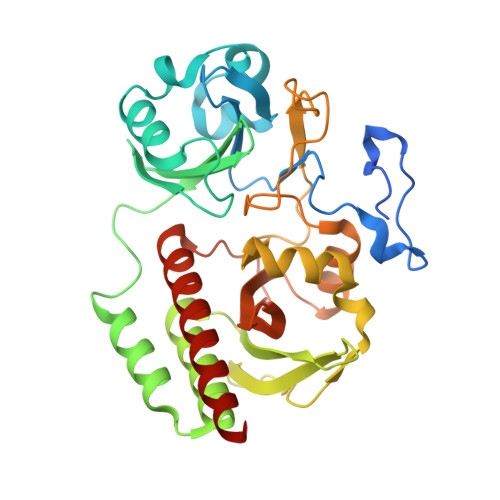Coordination of the biliverdin D-ring in bacteriophytochromes.
Lenngren, N., Edlund, P., Takala, H., Stucki-Buchli, B., Rumfeldt, J., Peshev, I., Hakkanen, H., Westenhoff, S., Ihalainen, J.A.(2018) Phys Chem Chem Phys 20: 18216-18225
- PubMed: 29938729
- DOI: https://doi.org/10.1039/c8cp01696h
- Primary Citation of Related Structures:
6FTD - PubMed Abstract:
Phytochrome proteins translate light into biochemical signals in plants, fungi and microorganisms. Light cues are absorbed by a bilin chromophore, leading to an isomerization and a rotation of the D-ring. This relays the signal to the protein matrix. A set of amino acids, which is conserved across the phytochrome superfamily, holds the chromophore in the binding pocket. However, the functional role of many of these amino acids is not yet understood. Here, we investigate the hydrogen bonding network which surrounds the D-ring of the chromophore in the resting (Pr) state. We use UV/vis spectroscopy, infrared absorption spectroscopy and X-ray crystallography to compare the photosensory domains from Deinococcus radiodurans, the phytochrome 1 from Stigmatella aurantiaca, and a D. radiodurans H290T mutant. In the latter two, an otherwise conserved histidine next to the D-ring is replaced by a threonine. Our infrared absorption data indicate that the carbonyl of the D-ring is more strongly coordinated by hydrogen bonds when the histidine is missing. This is in apparent contrast with the crystal structure of the PAS-GAF domain of phytochrome 1 from S. aurantiaca (pdb code 4RPW), which did not resolve any obvious binding partners for the D-ring carbonyl. We present a new crystal structure of the H290T mutant of the PAS-GAF from D. radiodurans phytochrome. The 1.4 Å-resolution structure reveals additional water molecules, which fill the void created by the mutation. Two of the waters are significantly disordered, suggesting that flexibility might be important for the photoconversion. Finally, we report a spectral analysis which quantitatively explains why the histidine-less phytochromes do not reach equal Pfr-type absorption in the photoequilibrium compared to the Deinococcus radiodurans wild-type protein. The study highlights the importance of water molecules and the hydrogen bonding network around the chromophore for controlling the isomerization reaction and spectral properties of phytochromes.
Organizational Affiliation:
Department of Biological and Environmental Sciences, Nanoscience Center, University of Jyväskylä, PO Box 35, FI-40014, Finland. janne.ihalainen@jyu.fi.

















